Fashion as Art: Rights and Remedies in the Age of Social Media
Abstract
:1. Introduction: Fashion and Art Intertwined
2. Background and Premises: The Widespread Recognition of Fashion’s Artistic and Cultural Value
3. The Legal Protection of Fashion as Art
3.1. From ‘Separability’ to ‘Artistic Value’ Requirement
3.2. Judicial Interpretation of ‘Artistic Value’ and Its Latest Developments
3.3. Enhanced Protection for Fashion? A New Separability Test
3.4. Copyright Fashion-Related Criticisms: (a) Unsuitable, (b) Unnecessary, (c) Harmful
3.5. The Digital Revolution
4. Fashion Controversies on Social Media Rather Than in Courtroom
4.1. Tuesday Bassen v. Zara
4.2. The Reputation Factor: The Cool and the Bully
4.3. Gucci and GucciGhost
4.4. Gucci and Dapper Dan
4.5. From Litigation through Settlement to Social Media: Advantages and Disadvantages
5. Social Media as an Alternative Method of Conflicts Resolution: Is This the End of the Story? A Caveat
Funding
Conflicts of Interest
Appendix A
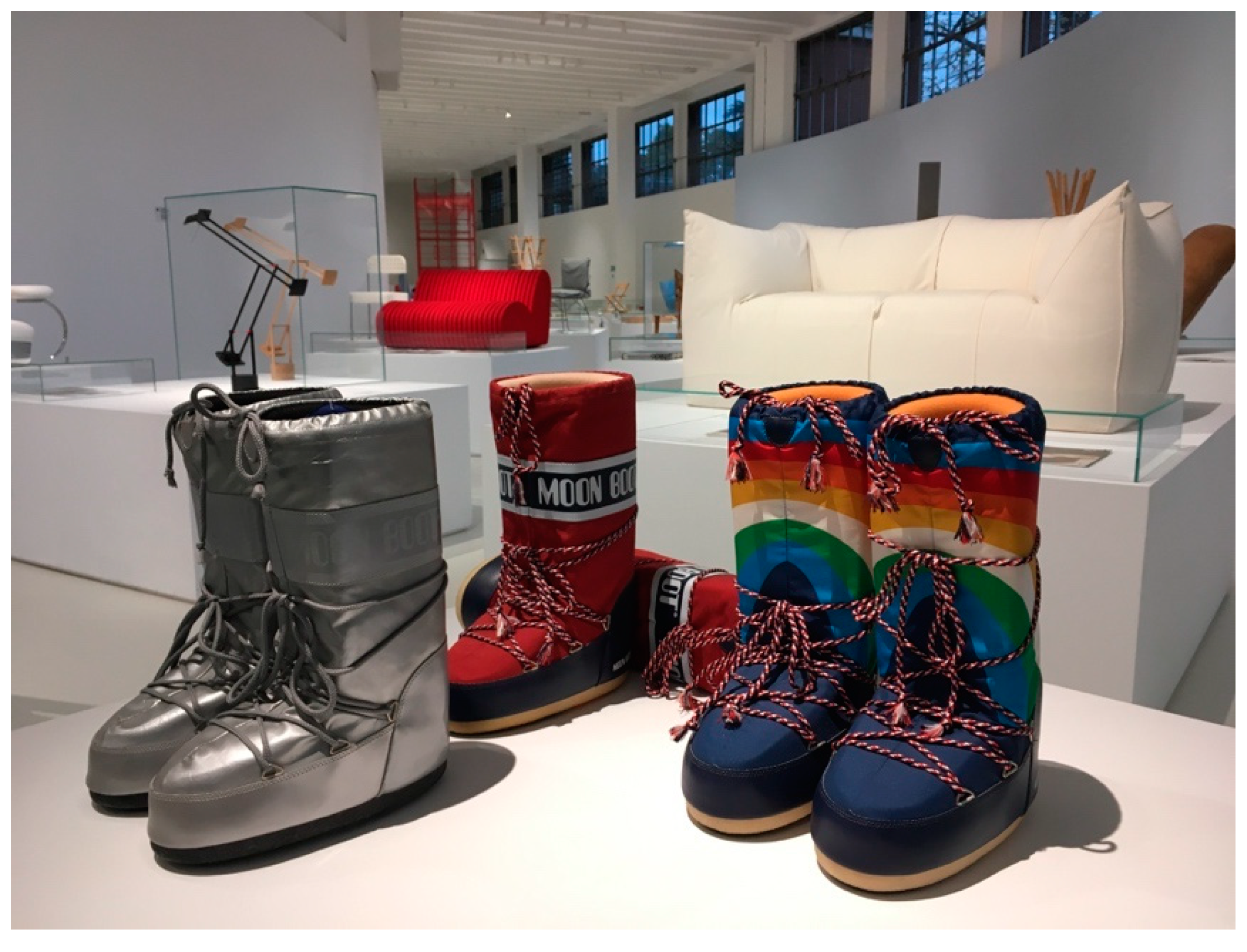
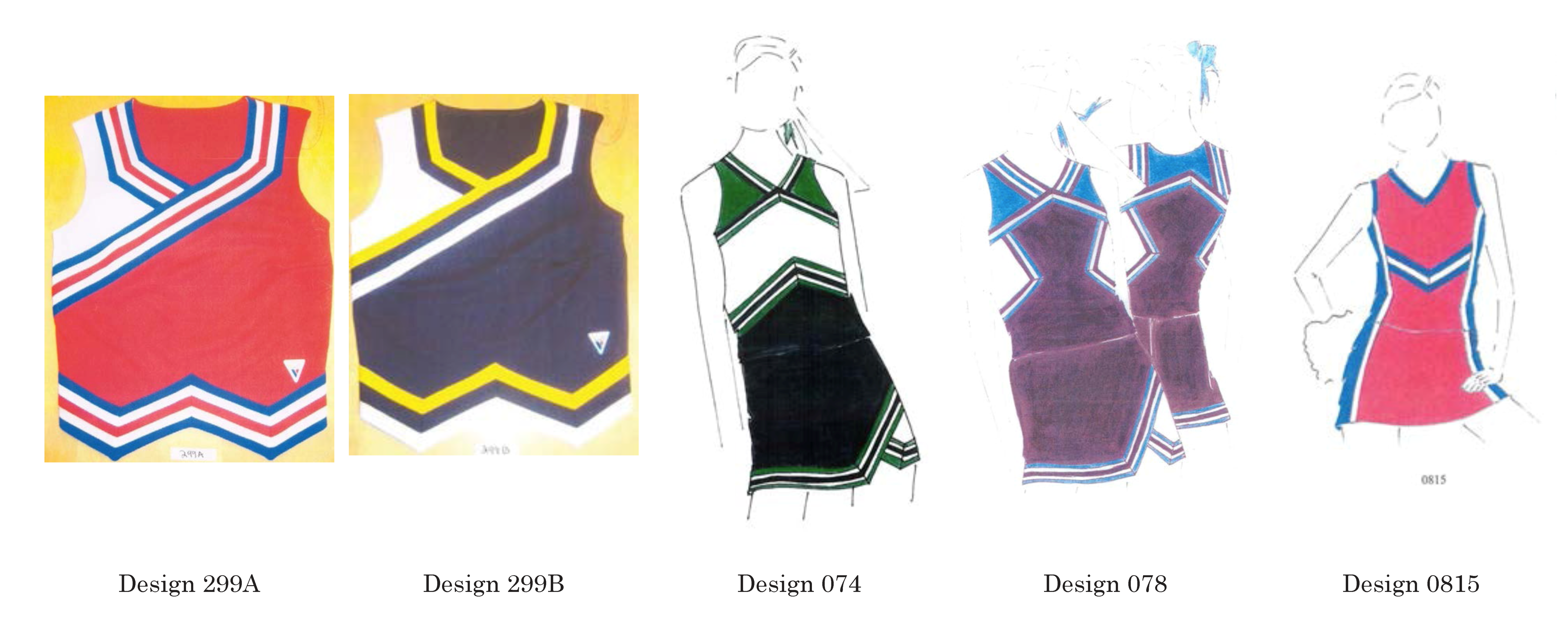
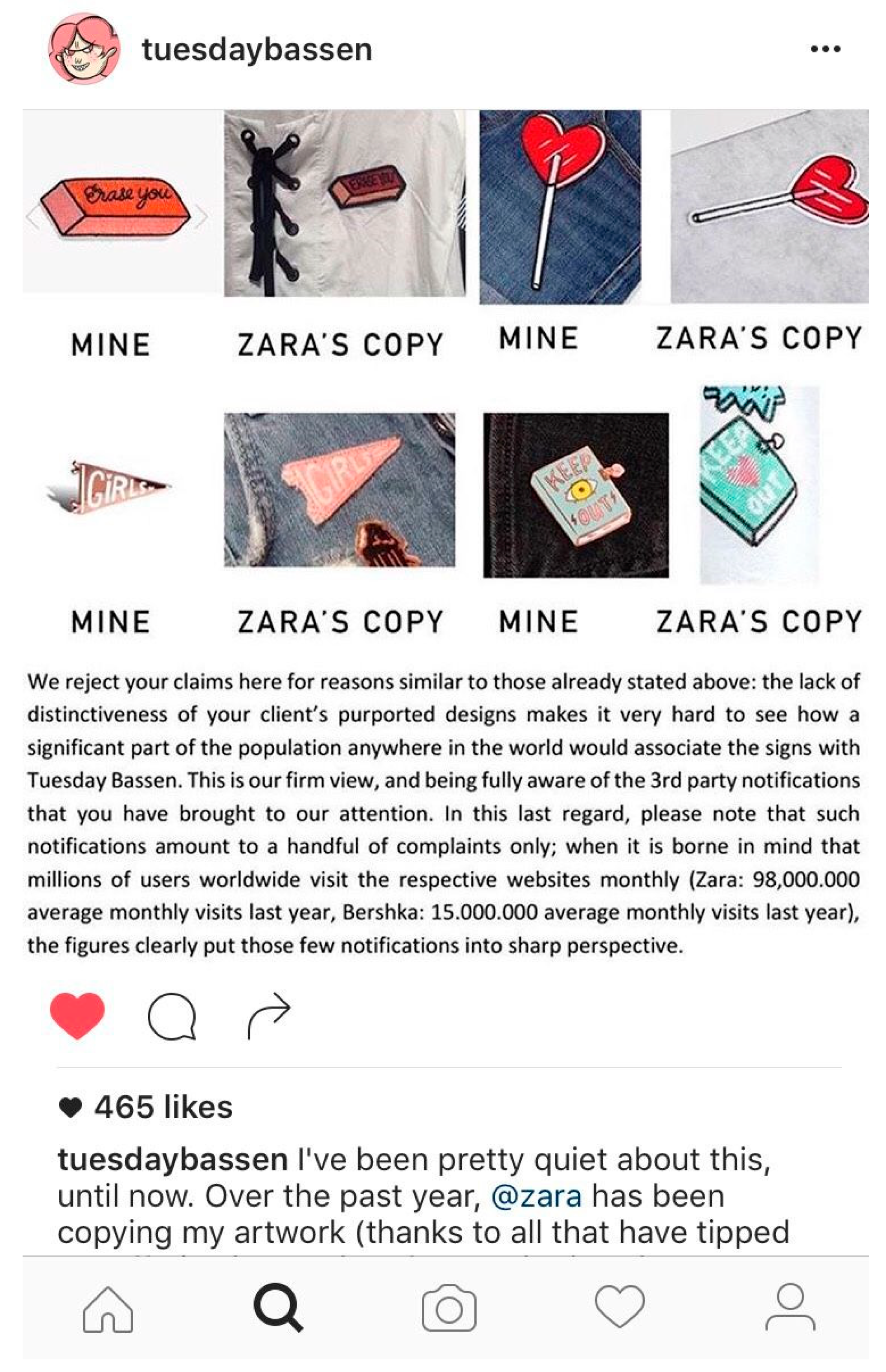

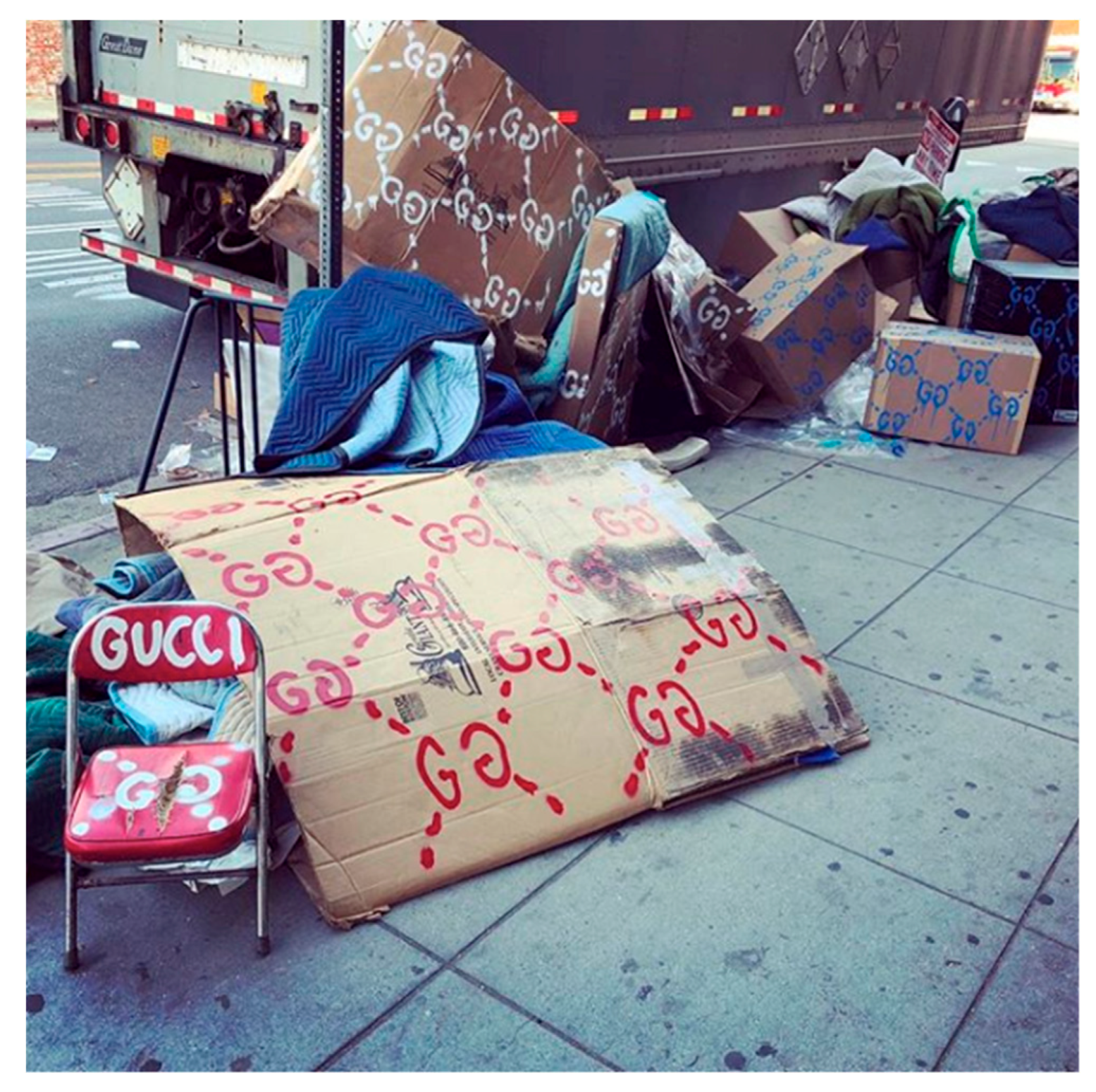

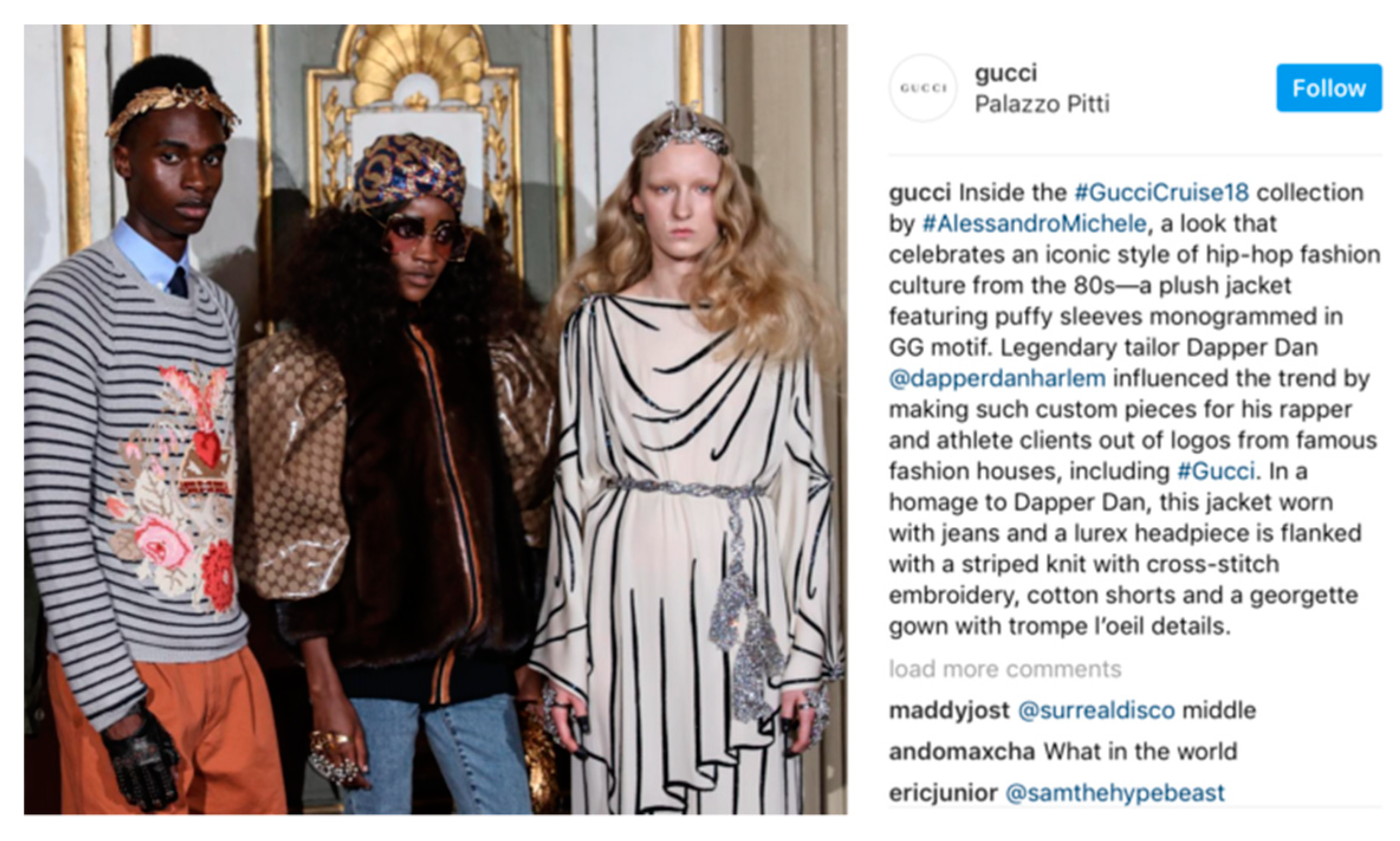
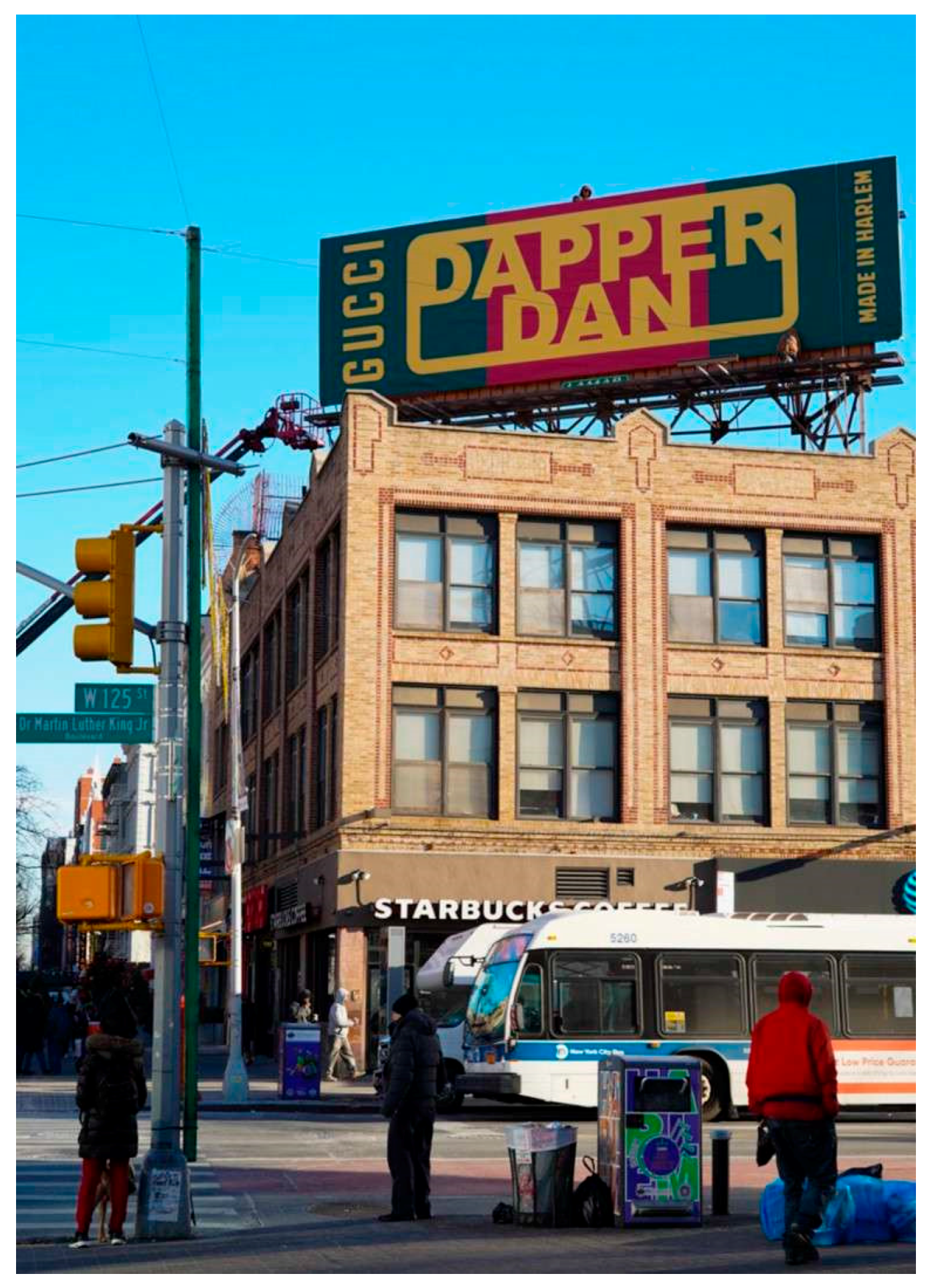
References
- Adler, Amy, and Jeanne C. Fromer. 2019. Taking Intellectual Property into Their Own Hands. California Law Review 107: 1455. [Google Scholar]
- Andrews, Katelyn N. 2012. The most fascinating kind of art: Fashion design protection as a moral right. The New York University Journal of Intellectual Property & Entertainment Law 2: 188. [Google Scholar]
- Arnold, Rebecca. 2009. Fashion: A Very Short Introduction. Oxford: Oxford University Press. [Google Scholar]
- Balkin, Jack M. 2004. Digital Speech and Democratic Culture: A Theory of Freedom of Expression for the Information Society. Yale Law School Faculty Scholarship Series 79: 1. [Google Scholar]
- Barabino, Sofia, and Elena Varese. 2016. Fashion Law. In Le Problematiche Giuridiche Della Filiera Della Moda. Edited by Barbara Pozzo and Jacometti Valentin. Milano: Giuffrè, pp. 93–108. [Google Scholar]
- Binkley, Christina. 2010. The Problem with Being a Trendsetter: Copycat Fashions Move Faster Than Ever, Making It Harder to Protect Original Ideas; Smaller Designers Bear the Brunt. Wall Street Journal, April 29. [Google Scholar]
- Bonelli, Giacomo. 2003. Industrial design e tutela del diritto d’autore. Diritto d’Autore 4: 519. [Google Scholar]
- Buccafusco, Christopher, and Jeanne C. Fromer. 2017. Fashion’s Function in Intellectual Property Law. Notre Dame Law Review 93: 51. [Google Scholar] [CrossRef] [Green Version]
- Calanca, Daniela, and Cinzia Capalbo. 2018. Fashion and Cultural Heritage. ZoneModa Journal 8. [Google Scholar]
- Caselli, Sara. 2017. Le ultime tendenze sulla tutela autorale del design e sul requisito del “valore artistico”. Rivista di Diritto Industriale 2: 333. [Google Scholar]
- Cutler, E. P., and Julien Tomasello. 2015. Art and Fashion: Collaborations and Connections between Icons. San Francisco: Chronicle Books. [Google Scholar]
- Dalle Vedove, Giampaolo. 2001. Dal modello ornamentale all’industrial design. Diritto d’Autore 3: 341. [Google Scholar]
- Denicola, Robert. 2018. Imagining Things: Copyright for Useful Articles after Star Athletica v. Varsity Brands. University of Pittsburgh Law Review 79: 635. [Google Scholar] [CrossRef] [Green Version]
- Ellis, Sara R. 2010. Copyrighting Couture: An Examination of Fashion Design Protection and Why the DPPA and IDPPPA Are a Step Towards the Solution to Counterfeit Chic. Tennessee Law Review 78: 163. [Google Scholar]
- Fabbio, Philipp. 2012. Disegni e modelli. Padova: CEDAM. [Google Scholar]
- Floridia, Giorgio. 1984. La protezione del diritto d’autore sulle opere dell’industrial design. Rivista di Diritto Industriale 1: 375. [Google Scholar]
- Franzosi, Mario, and Massimo Scuffi. 2014. Diritto industriale italiano. Padova: CEDAM. [Google Scholar]
- Galli, Cesare. 2004. Il design. In Il Codice Della Proprietà Industriale. Edited by Luigi Ubertazzi. Giuffrè: Milano. [Google Scholar]
- Geczy, Adam, and Vicki Karaminas, eds. 2012. Fashion and Art. London and New York: BERG. [Google Scholar]
- Giudici, Silvia. 1989. Dall’opera d’arte applicata all’industrial design. Rivista di diritto industriale 2: 269. [Google Scholar]
- Grinvald, Leah Chan. 2011. Shaming Trademark Bullies. Wisconsin Law Review 2011: 3. [Google Scholar] [CrossRef] [Green Version]
- Hernandez, Lazaro. 2011. Statement. In Innovative Design Protection and Piracy Prevention Act: Hearing on H.R. 2511 Before the Subcomm. on Intellectual Property, Competition, and the Internet of the H. Comm. on the Judiciary, 112th Cong. 4. Available online: https://www.govinfo.gov/content/pkg/CHRG-112hhrg67397/pdf/CHRG-112hhrg67397.pdf (accessed on 1 January 2020).
- Mann, Ronald. 2017. Opinion Analysis: Court uses cheerleader uniform case to validate broad copyright in industrial designs. SCOTUS Blog. March 22. Available online: https://www.scotusblog.com/2016/10/argument-preview-court-to-consider-copyright-protection-for-cheerleading-uniforms/ (accessed on 1 January 2020).
- Morri, Francesca. 2013. Le opere dell’industrial design tra diritto d’autore e tutela come modelli industriali: Deve cambiare tutto perché (quasi) nulla cambi? Rivista di diritto industriale 1: 177. [Google Scholar]
- Mulam, Kshithija. 2019. The Intellectual Property Implications of Star Athletica v. Varsity Brands. The Intellectual Property Implications of Star Athletica v. Varsity Brands. Undergraduate Law Review. April 15. Available online: https://www.culawreview.org/journal/the-intellectual-property-implications-of-star-athletica-v-varsity-brands (accessed on 1 January 2020).
- Norell, Norman, Louise Nevelson, Irene Sharaff, Alwin Nikolais, and Andre Courreges. 1967. Is Fashion an Art? The Metropolitan Museum of Art Bulletin New Series 26: 129–40. [Google Scholar] [CrossRef]
- Palavera, Rosa. 2016. Abbigliamento, diritto e marginalia. In Fashion Law. Le Problematiche Giuridiche Della Filiera Della Moda. Edited by Barbara Pozzo and Valentina Jacometti. Milano: Giuffrè, pp. 277–340. [Google Scholar]
- Raustiala, Kal, and Christopher Sprigman. 2006. The piracy paradox: Innovation and intellectual property in fashion design. Virginia Law Review 92: 1762. [Google Scholar]
- Raustiala, Kal, and Christopher Sprigman. 2009. The Piracy Paradox Revisited. Stanford Law Review 61: 1201. [Google Scholar]
- Rosati, Eleonora. 2019. CJEU rules that copyright protection for designs only requires sufficient originality. Journal of Intellectual Property Law & Practice 14: 12. [Google Scholar]
- Rosenblatt, Elizabeth. 2011. A Theory of Intellectual Property’s Negative Space. Columbia Journal of Law and The Arts 34: 317. [Google Scholar]
- Scafidi, Susan. 2005. Who Owns Culture? Appropriation and Authenticity in American Law. New Brunswick: Rutgers. [Google Scholar]
- Scafidi, Susan. 2006. A Bill to Provide Protection for Fashion Design. Hearing on H.R. 5055 Before the Subcommittee on Courts, the Internet, and Intellectual Property of the Committee on the Judiciary House of Representatives, 109th Cong. 2. Available online: https://www.govinfo.gov/content/pkg/CHRG-109hhrg28908/html/CHRG-109hhrg28908.htm (accessed on 1 January 2020).
- Scafidi, Susan. 2007. Intellectual Property and Fashion Design. In Intellectual Property and Information Wealth: Issues and Practices in the Digital Age. Edited by Peter K. Yu. Westport: Greenwood Publishing Group, vol. 1. [Google Scholar]
- Simmel, Georg. 1957. Fashion. The American Journal of Sociology LXII: 6. [Google Scholar]
- Sischy, Ingrid, and Germano Celant. 1982. Editorial. ArtForum 20: 34. [Google Scholar]
- Spada, Paolo, Paolo Auteri, and Gustavo Ghidini. 2002. Industrial design e opere d’arte applicata all’industria (dialogo tra Paolo Spada e Paolo Auteri commentato da Gustavo Ghidini). Rivista di Diritto Civile II: 272. [Google Scholar]
- Strahilevitz, Lior Jacob. 2005. A Social Network Theory of Privacy. University Chicago Law Review 72: 919. [Google Scholar] [CrossRef] [Green Version]
- Tsai, Julie. 2005. Fashioning Protection: A Note on the Protection of Fashion Designs in the United States. Lewis & Clark Law Review 9: 447. [Google Scholar]
- Vanzetti, Adriano, and Vincenzo Di Cataldo. 2018. Manuale di diritto industrial, 8th ed. Milano: Giuffrè. [Google Scholar]
- Wade, Margaret E. 2011. The Sartorial Dilemma of Knockoffs: Protecting Moral Rights without Disturbing the Fashion Dynamic. Minnesota Law Review 96: 336. [Google Scholar]
| 1 | Previous collaborations involved Paul Poiret with Raoul Dufy and Jeanne Paquin with Lèon Bakst of the Ballets Russes in pre-war France. In Italy, the Futurist movement was very engaged in the theory and the design of fashion. Several manifestos on clothing were issued over the years. Fortunato Depero designed the colorful futurist vests in 1923–1924, Giacomo Balla designed the Futurist men and women’s clothing, and Ernesto Thayaht invented the unisex jumpsuit. |
| 2 | The painter Piet Mondrian did not create the Mondrian day dress alongside Yves Saint Laurent for his 1965 Autumn collection, but the Dutch artist’s work served as inspiration for the designer to realize a dress that has become one of the most long-lasting symbols of the cross-fertilization between fashion and art. In 1966–67 the artist Andy Warhol, blurring the boundaries between art and fashion, designed a series of paper dresses titled the Souper dress for the Campbell Soup company, which gave each customer a dress in exchange for two soup cans’ labels plus one dollar. |
| 3 | The Metropolitan Museum of Art in New York organized a major exhibition of Yves Saint-Laurent’s works in 1983: it was the first time that such a recognition was granted to a living tailor. In 2017 Rei Kawakubo, founder of Comme des Garçons, will have been the next one to be recognized in this way. Schneier, Matthew. 2017. A Sneak Peek at the Met’s Rei Kawakubo/Comme des Garçons show. The New York Times, 6 March. Available at: https://www.nytimes.com/2017/03/06/fashion/rei-kawakubo-comme-des-garcons-met-museum-exhibit-paris-fashion-week.html. Since then, the MET hosted a number of fashion exhibitions, from the celebrated Alexander McQueen’s “Savage Beauty” in 2011, to the last, less conventional “Camp: Notes on Fashion”. Ferrier, Morwenna. 2019. How will Met Gala 2019 guests translate camp into costumes? The Guardian, 3 May. Available at: https://www.theguardian.com/fashion/2019/may/03/how-will-met-gala-2019-guests-translate-camp-into-costumes. In 2000, the Italian designer Giorgio Armani’s retrospective was presented at the Guggenheim Museum in New York and then moved to Bilbao, Berlin and London. Breward, Chris. 2003. Shock of the frock. The Guardian, 18 October. Available at: https://www.theguardian.com/artanddesign/2003/oct/18/art.museums (all websites last accessed on 1 January 2020). |
| 4 | Above all, the pioneeristic Anna Wintour Costume Center of the Metropolitan Museum of Art, with Diana Vreeland as a special consultant from 1972 to 1989, the Fashion Room (No. 40) of the Victoria & Albert Museum in London, but also the Museum of Costume and Fashion of the Uffizi Gallery in Florence and the Musée des Arts Décoratifs of the Louvre Museum in Paris. |
| 5 | In 2015, Alexander McQueen’s “Savage Beauty” show at the Victoria & Albert Museum in London broke all the records, being the most visited exhibition in V&A history and even prompting the museum to stay open 24 hours a day during the last weekends of the exhibition. See The Guardian, 3 August 2015, available at: https://www.theguardian.com/fashion/2015/aug/03/alexander-mcqueen-show-savage-beauty-most-popular-victoria-and-albert-history (last accessed on 1 January 2020). |
| 6 | The Prato Textile Museum in Italy is one of the most important cultural institutions for studying and preserving the textile industry, ancient and contemporary fashion. See the museum website: https://www.museodeltessuto.it/?lang=en (last accessed on 1 January 2020). |
| 7 | “European fashion industries are at the crossroads where manufacturing meets creativity.” Commission Staff Working Document. Policy Options for the Competitiveness of the European Fashion Industries ‘Where Manifacturing Meets Creativity’, Brussels, 26.9.2012, SWD (2012) 284 final. |
| 8 | The function of communication derived from wearing a piece of clothing, even if not a deliberate act of will and self-expression, is in any case unavoidable. “It’s impossible to wear clothes without transmitting signals” Morris, Desmond. 1977. Manwatching: A field guide to human behavior. New York: Abrams. “The right to wear is a corollary of the freedom of speech” (Palavera 2016). See Cohen v. California, 403 U.S. 15 (1971), the famous US Supreme Court case where wearing a jacket with the lettering “Fuck the draft. Stop the war” is obviously equivalent to verbal communication. However, also note Tinker v. Des Moines Independent Community School District 393 U.S. 503 (1969), where wearing black armbands to protest the Vietnam war is protected as symbolic speech “closely akin to pure speech”. “Symbolism is a primitive but effective way of communicating ideas”, West Virginia Bd. of Ed. v. Barnette, 319 U.S. 624, 632 (1943). It is worth to mention the related issue of fashion as identity. Fashion is inextricably related to both individual identity (cf. the artwork by Barbara Kruger “I shop therefore I am”) and collective identity (each subculture’s clothes are often well defined and recognizable, used as a sort of uniform expressing the identity of the group). See Barnard, Malcolm. 1996. Fashion as Communication. London: Routledge. A critical factor in the construction of identities through fashion is related to the so-called cultural appropriation issues, raising when the dynamism of communication leads mainstream fashion to improperly appropriate meanings that specific groups attribute to certain types of garments and accessories (see infra). |
| 9 | Code of Industrial Property (‘C.I.P.’), Legislative Decree no. 30 of 10 February 2005. The notion of Industrial Property was introduced as a sub-category of Intellectual Property (IP) by the Italian literature, simply to juxtapose intellectual products with an industrial character, regulated by industrial property law, to mere intellectual products, regulated by copyright law. In the United States, the notion of intellectual property has a partially different definitory and regulatory meaning. The notion covers indistinctly the different kinds of protection afforded by trademarks, design patents and copyrights. |
| 10 | Registered design, art. 31 ss. C.I.P. At the EU level, ‘unregistered design’ regime was introduced by art. 11 Regulation 6/02/CE of 21 December 2001. |
| 11 | Art. 45 ss. and 82 ss. C.I.P. |
| 12 | Art. 7 ss. C.I.P. Trademarks law was recently subject to significant amendments by Legislative Decree no. 15 of 20 February 2019 in compliance with the EU Directive 2015/2436. |
| 13 | Art. 2598 ss. Civil Code. |
| 14 | Legislative Decree no. 42 of 22 January 2004. |
| 15 | Law no. 633 of 22 April 1941 and art. 2575 ss. Civil Code. |
| 16 | Private collections need a specific declaration of cultural interest. For instance, last April 2019, the archive owned by the well-known Italian stylist Renato Balestra, featuring over forty thousand sketches and drawings, has been declared by the Archival and Bibliographic Superintendency of Lazio, on behalf of the MiBAC, an item of “particularly important historical interest” (art. 13 ss.), including it under the notion of “bene culturale”, according to the Code of Cultural and Landscape Property (art. 10). |
| 17 | Art. 10(5). On the subject, see Caponigri, Felicia. 2017. Problematizing fashion’s legal categorization as cultural property. Aedon. 2. See also Casini, Lorenzo. 2016. Ereditare il futuro. Dilemmi sul patrimonio culturale. Bologna: Il Mulino; Id. 2018. Riprodurre il patrimonio culturale? I “pieni” e i “vuoti” normativi. Aedon. 3. |
| 18 | Work summary, Study Commission for the Identification of Public Policies for the Protection, Conservation, Enhancement and Use of Italian Fashion as Cultural Heritage. Available on the Ministry of Cultural Heritage (MiBAC) website (last accessed on 1 January 2020). |
| 19 | Caponigri, Felicia. 2017. Problematizing fashion’s legal categorization as cultural property, cit. |
| 20 | I am aware that the terms ‘plagiarism’, ‘piracy’, and ‘counterfeiting’ have different technical meanings in both the Italian and the United States legal systems. In the present article, I use ‘plagiarism’ or ‘piracy’ when referring to copyright infringements; ‘counterfeiting’ is used when industrial property rights violations are involved. Generally, I tend to use the term ‘copying’. |
| 21 | Art. L. 112-1, French Code de la propriété intellectuelle: “Les dispositions du présent code protègent les droits des auteurs sur toutes les oeuvres de l’esprit, quels qu’en soient le genre, la forme d’expression, le mérite ou la destination”. |
| 22 | See Standing Committee on the Law of Trademarks, Industrial Designs and Geographical Indications, Ninth Session, Geneva, 11–15 November 2002. Industrial Designs and their Relations with Works of Applied Art and Three-Dimensional Marks. |
| 23 | French Code de la propriété intellectuelle, Art. L 112-2: “14°) Les créations des industries saisonnières de l’habillement et de la parure. Sont réputées industries saisonnières de l’habillement et de la parure les industries qui, en raison des exigences de la mode, renouvellent fréquemment la forme de leurs produits, et notamment la couture, la fourrure, la lingerie, la broderie, la mode, la chaussure, la ganterie, la maroquinerie, la fabrique de tissus de haute nouveauté ou spéciaux à la haute couture, les productions des paruriers et des bottiers et les fabriques de tissus d’ameublement”. |
| 24 | Art. 2.4, L. of 22 April 1941 n. 633, abrogated by Lgs. D. no. 95/2001: “works of sculpture, painting, drawing, engraving and similar figurative arts, including scenic art, even if applied to the industry, provided that their artistic value could be appreciated separately from the industrial nature of the products to which they pertained”. |
| 25 | 17 U.S.C. § 101 (1976): “The design of a useful article […] shall be considered [eligible for protection as a work of art] only if, and only to the extent that, such design incorporates pictorial, graphic, or sculptural features that can be identified separately from, and are capable of existing independently of, the utilitarian aspects of the article”. The 1976 Copyright Act, which revised the prior 1909 version, incorporated the Supreme Court landmark decision Mazer v. Stein, 347 U.S. 201 (1954), expressly protecting “two and three-dimensional works of fine, graphic, and applied art”. |
| 26 | Fiorucci spa v. Manifattura Naj Oleari spa, Civil Court of Cassation, sec. I, judgement no. 7077 of 5 July 1990; see also Como IP court, order of 12 February 1996. |
| 27 | Civil Cassation Court, sec. I, judgement no. 10516 of 7 December 1994, which denied copyright protection to the famous chaise-longue by Le Corbusier. |
| 28 | In most cases, US judges seem to base their decisions on a “we know it when we see it” rationale. See Perlmutter, Shira. 1990. Conceptual Separability and Copyright in the Designs of Useful Articles. J. Copyright Soc’y U.S.A. 37: 339. See also Keyes. 2008. Alive and Well: The (Still) Ongoing Debate Surrounding Conceptual Separability in American Copyright Law. Ohio State L. J. 69:109; Report of the House Committee on the Judiciary contextual to the entry into force of the Copyright Act (H.R. Rep. No. 94-1476 1976). A few important judgements: Kieselstein-Cord v. Accessories by Pearl, Inc., 632 F.2d 989, 990 (2d Cir. 1980), Carol Barnhart, Inc. v. And with. Cover Corp., 773 F.2d 411, 412 (2d Cir. 1985), Brandir International v. Cascade Pacific Lumber Co., 834 F.2d 1142 (2nd Cir. 1987), Whimsicality v. Rubie’s Costume Co., 891 F.2d 452 (2d Cir. 1989), Pivot Point International, Inc. v. Charlene Products, Inc. 372 F.3d 913, 930–31 (7th Cir. 2004), Jovani Fashion, Ltd. v. Fiesta Fashions, 500 Fed. App’x 42 (2d Cir. 2012), Star Athletica, LLC v. Varsity Brands, Inc., 580 U.S. _ (2017) (see infra). |
| 29 | Legislative Decree no. 95 of 2 February 2001. |
| 30 | Law on Copyright (n. 633/1941), Art. 2, n. 10: “works of industrial designs which themselves have a creative and artistic value”. |
| 31 | Article 17 of the Directive 98/71/EC. Art. 5.2 (prohibition of cumulative protection), D. R. no. 1411/1940, abrogated by Lgs. D. no. 95/2001. |
| 32 | Moral rights include right of attribution or paternity (art. 20 L. 633/41), right of integrity (art. 20 L. 633/41), right of withdrawal (art. 142 L. 633/41 and art. 2582 Civil Code), and right of disclosure (implied in the art. 142 L. 633/41). In the United States, moral rights do not apply to industrial design. After the late ratification of the Berne Convention in 1989, they are attributed “only to the author of a work of visual art” (VARA, 17 U.S. C. § 106A(b)) and explicitly excluded for applied art (17 U.S.C. § 101: “A work of visual art does not include—(A)(i) […] applied art”). See the latest US Copyright Office report on “Authors, Attribution, and Integrity: Examining Moral Rights in the United States”, 23 April 2019, available at: https://www.copyright.gov/policy/moralrights/full-report.pdf (last accessed on 1 January 2020). The extension of moral rights to fashion design is a recently debated issue among US academics and case law. On the implementation of a sui generis form of moral rights for fashion, see Ruff, Elise, 2017. If the Shoes Fit: The Effects of a Uniform Copyright Design Test on Local Fashion Designers. The John Marshall Review of Intellectual Property Law. 17:262; Andrews, Katelyn N. 2012. The most fascinating kind of art: fashion design protection as a moral right. N.Y.U. Journal of Intell. Prop. & Ent. Law. Vol. 2:188; and also, Akanegbu, Anuli. 2012. Fashion's Moral Dilemma: Exploring How a Lack of Moral Rights in the United States Disproportionately Harms Emerging Fashion Designers. 8 May. Available at: https://ssrn.com/abstract=2054783 or http://dx.doi.org/10.2139/ssrn.2054783 (last accessed on 1 January 2020). See also Wade, Margaret E. 2011. The Sartorial Dilemma of Knockoffs: Protecting Moral Rights without Disturbing the Fashion Dynamic. Minnesota Law Review. 96: 336; Hansmann, Henry, Santilli, Marina. 1997. Authors’ and Artists’ Moral Rights: A Comparative Legal and Economic Analysis. J. Legal Stud. 26: 95. |
| 33 | This is the case of the Moon Boot decision, see infra. |
| 34 | Cassina spa v. Dimensione Direct Sales srl, Bologna court, order of 3 August 2004; Cassina spa v. Galliani Host, Monza court, orders of 23 April 2002 and of 16 July 2002. |
| 35 | Vitra Patente ag v. High Tech srl, Milano IP court, order of 28 November 2006, confirmed in appeal by Milano IP court, order of 18 January 2007. See Naj-Oleari, Marella. 2007. Tutela d’autore per il design. Sole 24 Ore. 3 January. Available at: https://www.studioscarpellini.it/wp-content/uploads/2012/07/03gennaio2007.pdf (last accessed on 1 January 2020). |
| 36 | Id. |
| 37 | Vitra Patente ag v. High Tech srl, Milan IP court, judgement no. 9917 of 13 September 2012. |
| 38 | Flos spa v. Semeraro Casa & Famiglia spa, Milan IP court, judgement no. 74660 of 29 December 2006; Flos spa v. House World Arredamento, Florence specialized court for business matters, judgement no. 525 of 16 February 2010. |
| 39 | Cassina spa v. High Tech srl, Milan IP court, judgement no. 2311 of 17 February 2014. See also Ca. spa v. High Tech srl, Milan IP court, order of 28 April 2011. |
| 40 | Thun spa v. Egan srl, Civil Court of Cassation, sec. I, judgement no. 7477 of 23 March 2017; Metallo spa v. City design srl, Civil Court of Cassation, sec. I, judgement no. 23292 of 13 November 2015. See Fabbio, Philipp. 2016. Che cos’è arte? Una sentenza del Tribunale di Venezia sul “valore artistico” delle opere di design e sul giudizio dell’esperto. Riv. Dir. Ind. 1:62; Id. 2015. Contro una tutela autoriale “facile” del design. Considerazioni a margine di una recente pronuncia della Cassazione tedesca (Bundesgerichtshof, sent. 13 novembre 2013 - “Geburtstagszug”) e brevi note sul diritto italiano vigente. Riv. Dir. Ind. 2:45. |
| 41 | De. Be. v. Delettrez srl and De. De. Fe., Rome IP court, judgement of 13 June 2011. |
| 42 | Max Mara Fashion Group srl v. Liu Jo spa, Milan IP court, judgment no. 6397 of 21 May 2015, confirmed by Milan Court of Appeal, sec. 1, judgement no. 1893 of 5 May 2017. |
| 43 | Frame srl v. Conbipel spa, Torino IP court, order of 5 November 2013. |
| 44 | Rome IP court, order of 29 January 2015. |
| 45 | Tecnica group spa v. Anniel group spa, Milan IP court, judgement no. 8628 of 12 July 2016. |
| 46 | Varese, Elena, La tutela delle forme delle creazioni di moda: problemi e prospettive, 29 March 2019, lecture in the context of ‘Fashion Law. Diritto e cultura nella filiera della moda’ course, University of Florence. |
| 47 | This was the first case concerning industrial fashion products. Copyright was previously granted to a high fashion dress that was handmade and not industrially manufactured. It was a unique piece realized on commission for a showgirl who published the dress on her website without attribution. The dressmaker obtained the right to attribution and a compensation of court costs (Milan IP court, order of 11 December 2014). |
| 48 | Zhejiang Zhongneng Industry Group Co Ldt v. Piaggio & C. spa, Torino Court of appeal, sec. V, judgment no. 677 of 16 April 2019; Cassina spa v. Centrufficio Loreto spa, Milan IP court, order of 5 August 2017; Trifirò Salvatore v. Sony Music Entertainment spa, Milan IP court, order of 15 June 2017. |
| 49 | G.R. v. E.C., Bologna IP court, judgement no. 457 of 20 February 2019, regarding clothing; Rolex spa v. Swift Company srl, Torino IP court, judgment no. 1509 of 16 September 2019, regarding specific models of watch bezels by Rolex. |
| 50 | Dina Rinatovna Subkhankulova v. Prada spa, Milano IP court, judgement no. 8219 of 24 July 2017. |
| 51 | L.A.L. srl v. Ghirelli srl, Venice Court of Appeal, judgement of 2 May 2017. |
| 52 | Cofemel—Sociedade de Vestuario sa v. G-Star Raw cv, Court of Justice of the European Union, judgement C-683/17 of 12 September 2019. See Court of Justice of the European Union. Copyright protection may not be granted to designs on the sole ground that, over and above their practical purpose, they produce a specific aesthetic effect. Press Release No 109/19, Luxembourg, 12 September 2019. Available at: https://curia.europa.eu/jcms/upload/docs/application/pdf/2019-09/cp190109en.pdf (last accessed 1 January 2020). |
| 53 | Id. According to the Court, there is no original work whether originality is “dictated by technical considerations, rules or constraints which leave no room for creative freedom”. |
| 54 | The Lanham Act, against the sale of goods that bear confusingly similar marks, 15 U.S.C. § 1125(a) (2006), dilutive marks, § 1125(c), or counterfeit marks, § 1114. |
| 55 | A product may be protectable as ‘trade dress’ when it is so distinctive as to have ‘secondary meaning’, i.e. consumers associate the design of the product with its source and consider the design to be source identifying. See Wal-Mart Stores, Inc. v. Samara Bros., Inc., 529 U.S. 205 (2000). |
| 56 | 35 U.S.C. 171. |
| 57 | 17 U.S.C. § 101. |
| 58 | H.R. 5055, 109th Cong. (2006). |
| 59 | S. 3728, 111th Congress (2010). |
| 60 | S. 3523, 112th Congress (2012). |
| 61 | Star Athletica L.L.C. v. Varsity Brands Inc., cit. For case notes and comments, see Fashion Law Institute et al. 2017. Brief of Fashion Law Institute et al. as Amici Curiae in Support of Respondents in Star Athletica v. Varsity Brands. Available online: https://www.scotusblog.com/wp-content/uploads/2016/09/15-866-respondent-amicus-FLI.pdf (last accessed on 1 January 2020); Denicola, Robert. 2018. Imagining Things: Copyright for Useful Articles after Star Athletica v. Varsity Brands. U. Pitt. L. Rev. 79: 635; Caponigri, Felicia. 2017. Conceptual Separability in Star Athletica L.L.C. v. Varsity Brand Inc. et al: “Designs” of Useful Articles as (Non)Copyrightable Subject Matter? Law and Media working paper series. No. 5/2017; Buccafusco, Fromer; Ruff, Elise, 2017, cit.; Schroeder, Jared, Kraeplin, Camille. 2019. Give Me A ©: Refashioning the Supreme Court’s Decision in Star Athletica v. Varsity into an Art-First Approach to Copyright Protection for Fashion Designers. UCLA Entertainment Law Review. 26:1. |
| 62 | Star Athletica L.L.C. v. Varsity Brands Inc., cit. |
| 63 | Id. |
| 64 | Mazer v. Stein, cit. |
| 65 | Star Athletica L.L.C. v. Varsity Brands Inc., cit. |
| 66 | “Of the many fine lines that run through the Copyright Act, none is more troublesome than the line between protectible pictorial, graphic and sculptural works and unprotectable utilitarian elements of industrial design”, Goldstein, Paul. 1989. Copyright: Principles, Law and Practice. Boston: Little Brown. “Courts have twisted themselves into knots trying to create a test to effectively ascertain “whether the artistic aspects of a useful article can be identified separately from and exist independently of the article’s utilitarian function”. T Masquerade Novelty, Inc. v. Unique Indus., 912 F.2d 663, 670 (3d Cir. 1990). |
| 67 | Even only the first prong of the test, deciding whether the design is a pictorial, graphic or sculptural work, is a long-debating and unsolved question. Cf. “It would be a dangerous undertaking for persons trained only to the law to constitute themselves final judges of the worth of pictorial illustrations, outside of the narrowest and most obvious limits.” Justice Holmes, Bleistein v. Donaldson Lithographing Co., 188 U. S. 239, 251 (1903). The Holmes prescription has been repeatedly invoked by judges to justify their restraint in deciding about artistic matters, stating their inadequacy to engage in aesthetic determinations. See Palandri, Lucrezia. 2016. Giudicare l’arte. Le corti degli Stati Uniti e la libertà di espressione artistica. Firenze: FUP. |
| 68 | Star Athletica L.L.C. v. Varsity Brands Inc., cit. |
| 69 | Puma SE v. Forever 21, Inc. (2017), 2:17-cv-02523 U.S. District Court for the Central District of California. |
| 70 | Silvertop Associates Inc. v. Kangaroo Manufacturing Inc., No. 18-2266 (3d Cir. 2019). |
| 71 | Triangl Group Ltd. v. Jiangmen City Xinhui District Lingzhi Garment Company (S.D.N.Y. 2017). |
| 72 | Cofemel—Sociedade de Vestuario SA v. G-Star Raw CV, Court of Justice of the European Union, cit. |
| 73 | This is confirmed by interviews I conducted with Italian emerging designers, like the Florentine brand SuperDuper Handmade Hats. |
| 74 | See Wade, Margaret E. 2011, cit., 337: “Fashion piracy is not a new phenomenon, but with the rise of new technology and evolving consumer behaviors, copycat fashion is more common than ever before”. See also Adler, Amy, Fromer, Jeanne C. 2019. Taking Intellectual Property into Their Own Hands. California Law Review. 107: 1455; Roth, Judith S., Jacoby, David. 2009. Copyright Protection and Fashion Design. In Advanced seminar on copyright law (PLI Intellectual Prop. Handbook Ser. No. G-967, 2009): “The advent of online, real time access to the exhibition of new designs and rapid-fire manufacturing capabilities through CAD and other technological advances have facilitated design piracy”; Reasons to Stop Fashion Piracy: The Testimony of Susan Scafidi. 2006. Available at: http://www.arts-of-fashion.org/stopdesignpiracy.html (last accessed on 1 January 2020). |
| 75 | “[T]here [are w]eb sites now where you get a runway show, and they can literally zoom into the garment front and back, copy stitch for stitch, and pretty much print it and make it in a couple days flat and ship it before we ourselves can even take orders on the product”, Hernandez, Lazaro. 2011, cit. |
| 76 | Cf. my interview with Veronica Cornacchini and Matteo Gioli by SuperDuper Hats, talking about Zara insiders sent to Pitti Immagine in Florence, one of the most important fashion fairs in Italy, to photograph previews of new designs, 4 April 2019. |
| 77 | See Puglise, Nicole. 2016. Fashion brand Zara accused of copying LA artist’s designs. The Guardian, 21 July. Available at: https://www.theguardian.com/fashion/2016/jul/21/zara-accused-copying-artist-designs-fashion; Zara Comes Under Fire for Copying Indie Artists Designs. The Fashion Law, 20 July 2016. Available at: http://www.thefashionlaw.com/home/zara-comes-under-fire-for-copying-indie-artists-designs (both last accessed on 1 January 2020). |
| 78 | The Tumblr blog is still active at shoparttheft.tumblr.com. Such an instrument is very powerful, cf. the famous Diet Prada Instagram page and its unrelenting coverage on fashion allegedly copycatting cases, at https://www.instagram.com/diet_prada/ (both last accessed on 1 January 2020). |
| 79 | In 2016 Emily Oberg, designer for her own company Sporty & Rich, accused Forever 21 and Fresh Tops of replicating her graphic sweatshirt designs. James Soares accused Urban Outfitters of stealing his graphic printing designs that were sold on his site, Society 6 (Ruff 2017). |
| 80 | See Rosenblatt, Elizabeth L. 2013. Fear and Loathing: Shame, Shaming, and Intellectual Property. DePaul L. Rev. 63:1; and also Chan Grinvald, Leah. 2011. Shaming Trademark Bullies. Wis. L. Rev. 2011:625 (discussing how businesses and individuals use shaming techniques to defend themselves against trademark bullies). |
| 81 | Adler and Fromer (2019) underline the phenomenon of “cool” cease-and-desist letters as a way to subvert a “bully” label. See also Tim Nudd, Tim. 2017. Netflix Sent the Best Cease-and-Desist Letter to This Unauthorized Stranger Things Bar. AdWeek, 20 September, reporting positively on a “quite adorable” cease-and-desist letter written to the owners of an unauthorized Stranger Things bar “in the style of the Stranger Things universe”. Rosenblatt (2013) discusses a creative cease-and-desist letter from Jack Daniel’s that generated good publicity for the rightsholder. On the contrary, the Mattel company has many times proven to be “not cool”. First, suing the MCA Records for the pop song ‘Barbie Girl’ by Aqua, see Mattel, Inc. v. MCA Records, Inc., 296 F.3d 894 (9th Cir. 2002). Then, deciding to sue the artist Tom Forsythe, who photographed naked Barbie dolls in absurd sexual positions on kitchen appliances, creating the series “Food Chain Barbie”, see Mattel, Inc. v. Walking Mountain Productions, 353 F.3d 792, 802 (9th Cir. 2003). |
| 82 | It is not the first episode of the controversy between Plesner and Vuitton. A different lawsuit was filed by the fashion brand against the artist in 2008. See Artist Chronicles 3-Year fight with Louis Vuitton in New Book. The Fashion Law, 9 July 2015. Available at: http://www.thefashionlaw.com/home/artistfightslouisvuitton (last accessed 1 January 2020). |
| 83 | Nadia Plesner Joensen v. Louis Vuitton Malletier sa, Court of the Hague, Civil Law Section, 389526/ KG ZA 11-294, 4 May 2011. Nadja Plesner published on her website the verdict delivered by the court of the Hague: http://www.nadiaplesner.com/upl/website/simple-living--darfurnica1/VerdictEnglish.pdf (last accessed on 1 January 2020). |
| 84 | On the case, see Adler, Fromer. 2019, cit. Additionally, see Gucci’s Alessandro Michele: Creative Genius or Glorified Copycat? The Fashion Law, 9 August 2017. Available at: http://www.thefashionlaw.com/home/guccis-alessandro-michele-saddened-by-claims-of-copying; and In Conversation with Trouble Andrew on Gucci website: https://www.gucci.com/it/it/st/stories/inspiration-and-codes/articles/agenda_2016_issue05_guccighost_collection_troblu_andrew_qa (both last accessed on 1 January 2020). |
| 85 | The US ‘fair use’ doctrine is a defense against a claim of copyright infringement on the basis of a limited and ‘transformative’ use, such as parody, of copyrighted works. |
| 86 | See Schneier, Matthew. 2017. Did Gucci Copy ‘Dapper Dan’? Or Was It ‘Homage’? The New York Times, 31 May. Available at: https://www.nytimes.com/2017/05/31/fashion/gucci-dapper-dan-jacket.html; Cooper, Barry Michael. 2017. The Fashion Outlaw Dapper Dan. The New York Times, 3 June. Available at: https://www.nytimes.com/2017/06/03/fashion/dapper-dan-harlem-gucci.html; Cochrane, Lauren. 2017. Homage or copy? Why fashion (especially Gucci) loves Dapper Dan. The Guardian, 2 June. Available at: https://www.theguardian.com/fashion/2017/jun/02/homage-or-copy-why-fashion-especially-gucci-loves-dapper-dan (all last accessed 1 January 2020). |
| 87 | Cartner-Morley, Jess. 2017. Dapper Dan and Dries van Noten address cultural appropriation debate. The Guardian, 1 December. Available at: https://www.theguardian.com/fashion/2017/dec/01/dapper-dan-and-dries-van-noten-address-cultural-appropriation-debate (last accessed on 1 January 2020). |
| 88 | This is the subject of an upcoming article. |
| 89 | Costs of access to justice in civil proceedings are expensive and include court fees, lawyer fees, transportation costs, time spent by litigants on a procedure. Even if big fashion companies could afford such costs, they still would need to adjust for the increased costs of litigation and filing expenses, and they would likely pass these new costs on to consumers, meaning raising the cost of clothing. |
| 90 | Article 111 of the Italian Constitution sets the principles of the due process of law. Art. 111 states that all parties shall be entitled to equal conditions before an impartial, third-party judge. To guarantee that, all judicial decisions shall include their reasoning. Furthermore, any party can appeal to the Supreme Court of Cassation in case of violations of law. In the United States, Fifth and Fourteenth Amendments contain a due process clause that, due to the broad interpretation by the Supreme Court, includes the protection of fair procedures. |
| 91 | The risk is that a copyist might bring a lawsuit for defamation against excessive shaming. However, most of the contents posted on social media are the truth, plus are statements of opinions rather than facts. These conditions are absolute defenses to defamation. For such reasons, a defamation lawsuit is unlikely to succeed. |
| 92 | https://libra.org/en-US/. Kharif, Olga. 2019. Why (Almost) Everybody Hates Facebook’s Cryptocurrency Libra. Bloomberg, 16 July. Available at: https://www.bloomberg.com/news/articles/2019-07-16/why-everybody-almost-hates-facebook-s-digital-coin-quicktake (last accessed 1 January 2020). |
© 2020 by the author. Licensee MDPI, Basel, Switzerland. This article is an open access article distributed under the terms and conditions of the Creative Commons Attribution (CC BY) license (http://creativecommons.org/licenses/by/4.0/).
Share and Cite
Palandri, L. Fashion as Art: Rights and Remedies in the Age of Social Media. Laws 2020, 9, 9. https://doi.org/10.3390/laws9010009
Palandri L. Fashion as Art: Rights and Remedies in the Age of Social Media. Laws. 2020; 9(1):9. https://doi.org/10.3390/laws9010009
Chicago/Turabian StylePalandri, Lucrezia. 2020. "Fashion as Art: Rights and Remedies in the Age of Social Media" Laws 9, no. 1: 9. https://doi.org/10.3390/laws9010009
APA StylePalandri, L. (2020). Fashion as Art: Rights and Remedies in the Age of Social Media. Laws, 9(1), 9. https://doi.org/10.3390/laws9010009




